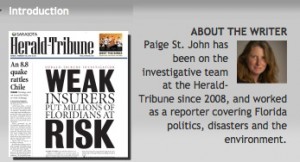Our popular business beat basics series is now available all in one place in ebook form for your convenience. Go here to download the Reynolds Center’s free ebook, Business Beat Basics.
***
In this video, reporter Paige St. John describes her investigation of the insurance industry in Florida, for which she won the 2011 Pulitzer Prize for Investigative Reporting.
Insurance companies don’t speak English. Neither do regulators, actuaries or even lawmakers for that matter.
The challenge to getting a good insurance story into print, and an even bigger obstacle to getting it onto the air, is translating it into common words.

Then think about what you see and hear as you report, and ask if it makes sense.
This process of translating and challenging will help you dig beneath the Astroturf to find real dirt and real stories.
Biloxi’s Anita Lee, a police and local politics reporter, took on State Farm (PDF) for bad faith in handling claims after Hurricane Katrina. Her advice to reporters thrown into a similar kettle: “challenge at every opportunity the secrecy so pervasive in the industry.”
Good sources will help you work your way through the labyrinth. Tap local insurance agents, state consumer advocates and organizations such as the Consumer Federation of America. Some states have a consumer advocate.
Read others’ works on the same subjects and note whom they spoke to. People who work in the background – legislative aides and regulatory analysts – can be a big help in getting started, even if they won’t be quoted.
Though the topic was high finance, Reynolds Center blogger Rosland Gammon relays great advice from ProPublica Pulitzer winner Jake Bernstein, who encouraged reporters to talk to as many people as possible and to enter interviews with a willingness to learn.
Bernstein names two tools that help turn mud into crystal: Return to sources again and again until you are sure you understand what they are saying; and take a stab at writing parts of the story early.
Early drafts will highlight holes in your understanding. It also will show where what you know adds up to something more – a larger pattern or a deeper impact. Rewrite the rewrites, to further distill and synthesize difficult and complex issues. Your hard work will make an easy read with stronger impact.
Bring your editor on board early, too. They often face the same high learning curve that comes with insurance, and it will save a lot of struggle and pain if your editor understands the issues you’re working with.
Equally valuable is a read by an editor who knows nothing about insurance. Every one of the Sarasota Herald-Tribune’s “Insurance Nightmare” stories went through a final understandability test on our metro desk, to make sure readers would not be left in the fog. The series won the 2011 Pulitzer Prize for Investigative Reporting.










